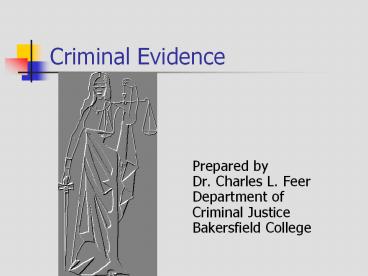Criminal Evidence - PowerPoint PPT Presentation
1 / 22
Title:
Criminal Evidence
Description:
Criminal Evidence Prepared by Dr. Charles L. Feer Department of Criminal Justice Bakersfield College Aspects of the Criminal Justice System Participants: Court Room ... – PowerPoint PPT presentation
Number of Views:1113
Avg rating:3.0/5.0
Title: Criminal Evidence
1
Criminal Evidence
- Prepared by Dr. Charles L. FeerDepartment of
Criminal JusticeBakersfield College
2
Aspects of the Criminal Justice System
- ParticipantsCourt Room Players
- ProcessAnatomy of a trial
- Evidence of proof- Circumstantial- Inferences
- - Presumptions
- - Stipulations
3
Court Room Players
- Judge
- Clerk
- Reporter
- Bailiff
- Prosecutor
- Defense Attorney
- Defendant
- Jury
4
Anatomy of a Trial
- Prosecutions evidence-in-chief
- Defenses evidence-in-chief
- Prosecutions evidence in rebuttal
- Defenses evidence in rejoinder
5
Step-by-Step The Trial Process
- Opening Statement
- Case-in-Chief
- Direct Examination
- Cross Examination
- Motion for Judgment of Acquittal
- Closing Statements
- Prosecutions Rebuttal Statement
6
Roles in the Trial
- JUDGE Determines the law and instructs the
jury. - JURY Determines the facts from evidence
presented in court. - WITNESS Presents evidence from which the jury
determines the facts.
7
Evidence can be definedin four different ways
- The Lay Persons Definition
- The Legal Definition
- The Technical Definition
- The Law Enforcement Officers Definition
8
The Lay PersonsDefinition of Evidence
- Evidence is information that people base
decisions on and is used as the means by which
those facts are proved or disproved.
9
The Legal Definition of Evidence
- In a legal sense, evidence is any information
about the facts of a case, including tangible
items, testimony, and documents, photographs, or
tapes, which, when presented to the jury at
trial, tends to prove or disprove these facts.
10
The Technical Definitionof Evidence
- Technically, evidence consists of
- Testimony or physical items presented to the
judge and jury that they use to. - decide the truth of an assertion,
- the existence of a fact, and.
- ultimately the guilt or innocence of the accused
in a criminal case.
11
The Law Enforcement Officers Definition or View
of Evidence.
- Evidence, to the officer, is
- Articles collected at a crime scene
- Items found on a suspect, or in the suspect's car
or home - Things discovered during investigation.
12
Evidence of Proof
- Circumstantial
- Inferences
- Presumptions
- Stipulations
13
Circumstantial Evidence
- Evidence which proves a fact through inference,
or logical association with other facts.
14
Inference
- Is the drawing of a conclusion from an
observation or series of observations
15
Presumptions
- A presumption permits the fact-finder to conclude
that, because a party has introduced evidence
that one fact exists "basic fact", the jury may
conclude that another fact "presumed fact"
exists, even though the party has not introduced
any other evidence of the existence of the
presumed fact.
16
The Supreme CourtsTest for Presumptions
- The Court has declared that, at a minimum, the
presumed fact must flow from the basic fact
measured by a standard of a preponderance of
evidence.
17
Stipulations
- There are other facts that may be presented
during a trial without formal proof being
required. - These are facts upon which the parties and their
attorneys agree. - This agreement may take place either before or
during the trial. - Once agreement has been reached, it will not be
necessary to call witnesses to present the facts.
18
The Funnel Effect of the Standard of Proof
19
The Spectrum of the Standards of Proof. Can you
tell when each standard applies?
- Preponderance of the evidence
- Mere hunch
- Reasonable suspicion
- Probable cause
- Clear and convincing evidence
- Absolute certainty
- Beyond a reasonable doubt
Arrange them in order. See next slide.
20
Burden of Proof
21
A Case Law Definitionof Reasonable Doubt
- It is not a mere possible doubt because
everything relating to human affairs is open to
some possible or imaginary doubt. It is that
state of the case which, after the entire
comparison and consideration of all the evidence,
leaves the minds of the jurors in that condition
that they cannot say they feel an abiding
conviction of the truth of the charge. - Victor v. Nebraska, 511 U.S. 1 (1994)
22
(No Transcript)































